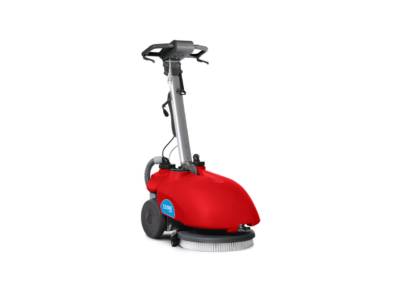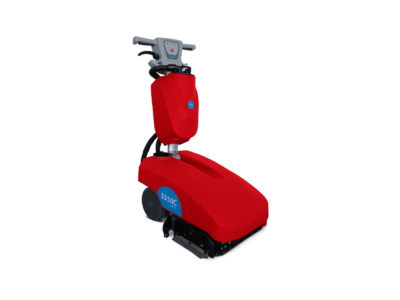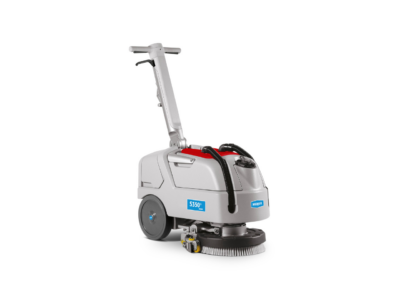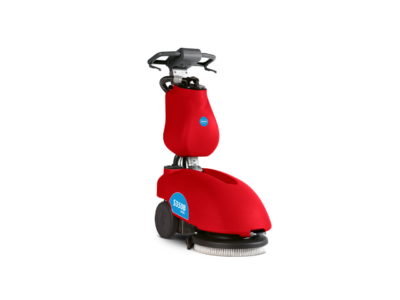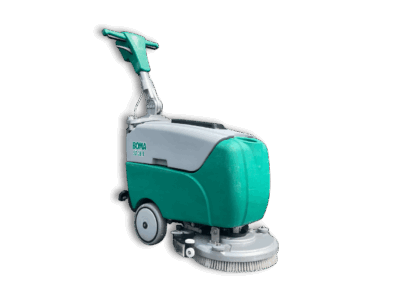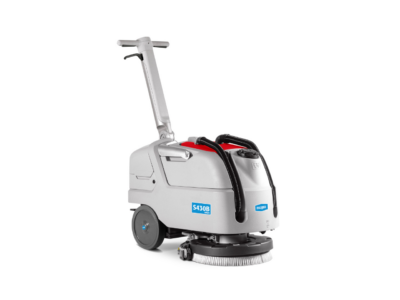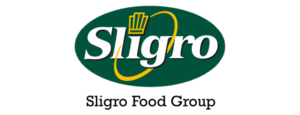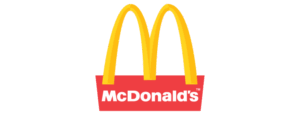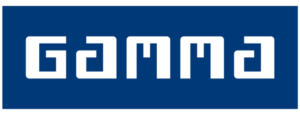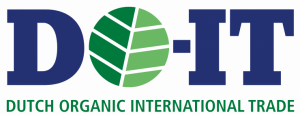- What are the advantages of a scrubber over manual cleaning?
Professional scrubbers clean faster and more efficiently than manual cleaning, provide consistent cleaning quality, reduce physical strain on the operator and are often better at removing stubborn dirt and stains. These answers provide a basis for understanding what is involved in buying a scrubber. For specific situations, it is always a good idea to seek further advice from a specialist.
- What types of scrubbers are available?There are four main types of scrubbers: walk-behind scrubbers, sit-on scrubbers, sweeping scrubbers and a disc scrubbers. Walk-behind scrubbers and sit-on scrubbers have water tanks and a water suction system. Single-disc scrubbers have only a scrubbing system, without water suction. Sweeping-scrubbing machines sweep and scrub the floor in one pass and suck up the dirty water directly.
- How do I determine the right size of scrubber for my needs?
The size of the professional scrubber should match the size of the area to be cleaned. For small areas and narrow passages, a compact or walk-behind scrubber is suitable, while for larger industrial areas, a sit-on scrubber is more appropriate.
- What are the most important features to look out for when buying a scrubber?
Key features include brush pressure, water tank capacity (clean and holding tank), working width, battery life or cable range, maneuverability and additional features such as automatic detergent dosing.
- Is a scrubber suitable for my type of floor?
Professional scrubbers are suitable for different types of hard floors such as tile, concrete, vinyl, and hard wood floors. It is important to choose a scrubber suitable for your specific floor type and use the right brushes (or pads) and cleaning agents.
- How much does a scrubber cost?
The cost of professional scrubbers varies widely depending on type, size and features. New walk-behind scrubbers start from €2,000 on average, while new sit-on scrubbers can cost between €6,900 and €40,000 or more. Used walk-behind scrubbers start around €1,500 and used sit-on models from around €4,900. The price is determined by the condition of the used machine, here you can choose to what extent the machine will be reconditioned. Either way, it will be delivered in good technical working order. New single-disc scrubbers start from about € 1,500.
- How do I maintain a scrubber?
Regular maintenance of a scrubber includes cleaning the brushes, emptying and cleaning the water tanks, checking and replacing the filters if necessary, and charging and maintaining the battery. Always follow the manufacturer's maintenance instructions to extend the life of the machine.
- Do I need training to use a scrubber?
Although most scrubbers are user-friendly, brief training can be helpful to learn how to operate the machine safely and efficiently, especially with larger and more complex models. Many vendors offer training or instructional videos.
- What is the average lifespan of a scrubber?
The lifespan of a professional scrubber depends on its use, maintenance and quality. On average, a well-maintained scrubber lasts between five and 10 years.
- Can I lease or rent a scrubber?Yes, many suppliers offer lease- or rental options available. This can be a good option if you want to spread the cost of a new scrubber or if you only need a machine temporarily.
- Where can I buy spare parts and accessories?
Spare parts and accessories can usually be purchased from the supplier or manufacturer of the scrubber. Many suppliers also have an online store where you can order parts such as brushes, rubbers and filters. Metech has a large network of suppliers and can provide you with a replacement part in most cases.
- How does a scrubber work?
A scrubber works by spraying water and detergent onto the floor, then rotating brushes or pad holders scrub the floor. The dirty solution is then sucked up and stored in a holding tank, leaving the floor clean and dry.
Scrubbers
At Metech, we have the best scrubbers for cleaning efficiency and convenience. Our powerful machines simplify your cleaning routine. Whether you want to clean a floor in a warehouse, production site or in a hospital, our scrubbers will get any floor spotless. With several makes, models and features, you'll find the perfect machine to fit your needs.
Home
Working width
Condition
Brands
Power source
Walk-behind or ride-on
Need help choosing?
Because of the many options, finding the right machine can be a challenge. Our advisors will be happy to help you find a cleaning machine suitable for your type of floor, type of soiling and surface area. Fill out the form and we will contact you for no-obligation advice.
"*" geeft vereiste velden aan
Why companies choose a scrubber from Metech.
At Metech you will find a wide selection with new, occasion and demo scrubbers for every situation. From walk-behind to sit-on models, we always have suitable machines from various brands in stock.
Not sure which scrubber is best for your type of floor, dirt or surface? Then request a no-obligation consultation or on-site demo.
- Occasions are completely prepared technically upon purchase (new battery pack, brushes, wear parts, etc.)
- Excellent service and short delivery times
- Free on-site demonstration to see which machine best suits your situation

Largest selection in Europe
We always have more than 700 machines in stock, allowing us to deliver quickly.
9.2 client rating
Our clients have rated our company with a score of 9.2. This rating is based on independent reviews sent via Feedback Company.
The right machine for every budget
If you’re looking for a new or used sweeper or scrubber, you’ve come to the right place! With our wide range of machines, you’re sure to find one that fits your budget and meets your needs.
"Prompt service, clear explanation and advice in terms of maintenance and use of our scrubber. Neat and skilled mechanic."
Choose a professional scrubber
Are you looking for the best scrubber for professional use? At Metech, we have the largest selection of scrubbers for sale throughout Europe, designed to meet all your cleaning needs. A professional scrubber provides excellent cleaning power, efficiency and reliability for a variety of floor surfaces. Some brands to choose from are:
At Metech, we understand that you can't just buy a large or small scrubber buys, without knowing whether it can handle what it will be used for. That's why we always look at a number of points that lead to the most suitable professional scrubber before we give advice. Some of these points are as follows:
The area to be cleaned: together with you, we look at the space to be cleaned. For example, is this a warehouse with shelving? Or is it a school building with a lot of built-in benches? This is one of the most important points to consider.
The working time: if it is important for the scrubber to be able to scrub for many hours in a row, we always look at the working time of the battery and the capacity of the water tanks. In fact, these can vary from one professional scrubber drier to another and determine how long you can work with it at a stretch.
Floor type: obviously, it is important to consider the type of floor to be cleaned. For example, is it a smooth floor or just a rough and rough floor like a gravel floor? Not all scrubbers are suitable for all types of floors. Therefore, we provide advice on the use of cleaning agents and which type of brush gives the best results.
We are ready to help you buy a professional scrubber that can meet your business environment!
Ensuring workplace safety and hygiene with a scrubber
There are various laws and regulations about ensuring safety and hygiene in the workplace. A clean floor is, of course, part of this. With regular scrubbing, you prevent a dirty, slippery, sticky or greasy floor and create a safe and hygienic working environment for all employees. Our scrubbers are designed to effectively remove dirt and grease, making the floor not only clean but also slip-free, minimizing the risk of accidents. This contributes to a professional appearance of the workplace and ensures an optimal work environment where everyone can work with confidence and safety.
Buying a new or occassion scrubber?
We offer not only new scrubbers, but also used machines. The range of new scrubbers consists mainly of our own brand 'Meijer'. When it comes to used scrubbers, we offer a wide range of well-known brands with varying working widths, features and years of manufacture.
Free on-site consultation
Our goal at Metech is to help you make the best choice when it comes to scrubbers. We understand that selecting the right machine can be a challenging task, which is why we not only offer expert advice, but also stand ready to provide this advice on site. If possible, we will bring one or two machines with us so you can really experience them.
Whether you already know exactly which machine you want, still want advice on which scrubber is best for your floor type or want more insight into the different features and capabilities, our team is here to help. By offering no-obligation advice, we strive to find the best solution to fit your specific needs and budget.
Our experts come to you, review the situation and listen to your needs before offering personalized advice. We strive to help you make the right decision.
Using the Metech Search Service
Already have a specific machine in mind, but you can't find it anywhere and it's not listed among our offerings? No worries! Contact us via the Metech Search ServiceIf you are looking for a scrubber, we will search at home and abroad to find it for you. With our Search Service it does not matter what you are looking for, we are happy to help you.
So, based on the brand, type or special features, we will look for your perfect match on scrubbers!
Fill out the contact form for a quote or demonstration
Wondering which scrubber is best for your situation? Request a no-obligation quote or demonstration today. Our specialists will be happy to help you with personal advice, tailored to your floor type, soiling and cleaning frequency. Fill in the contact form and discover how easy professional cleaning can be with the right cleaning machine. So you will always make a thoughtful choice for a clean, safe and efficient workplace!
